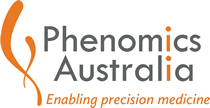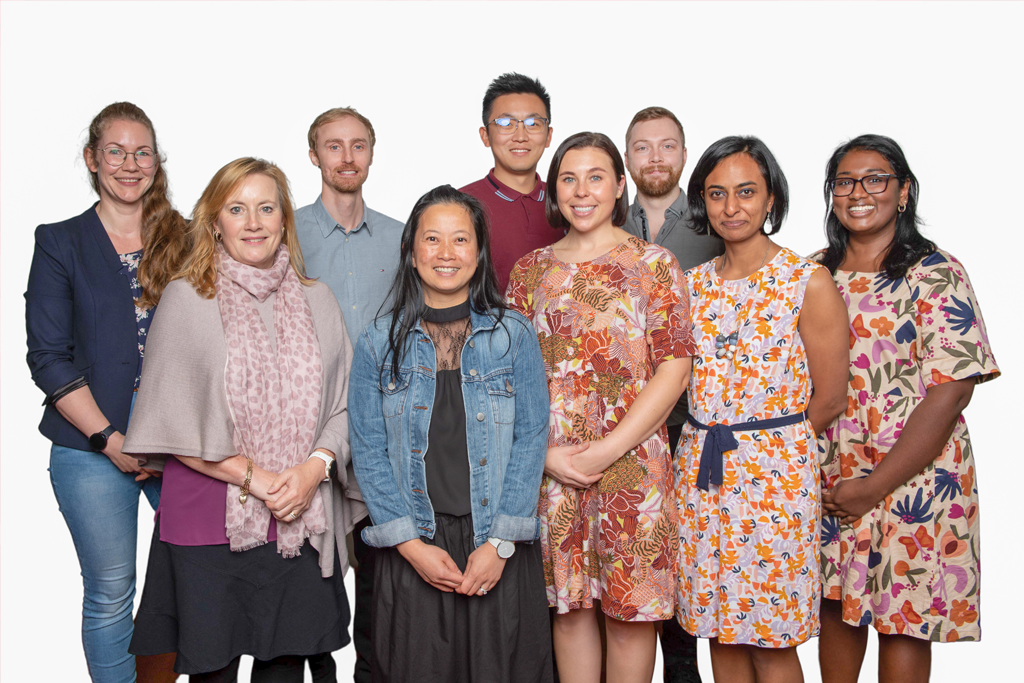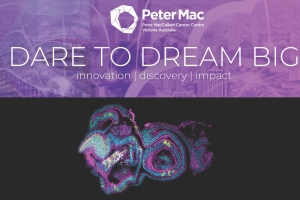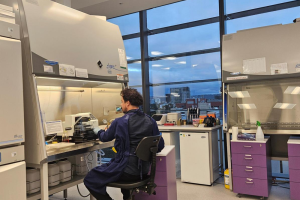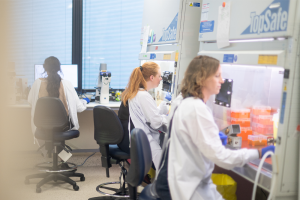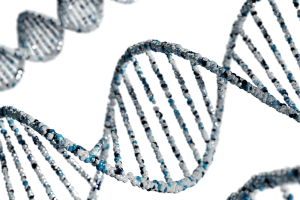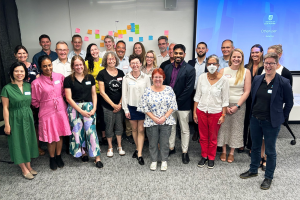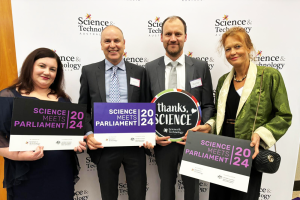Phenomics Australia and TIA co-investment in the Victorian Centre of Functional Genomics (VCFG)
The Victorian Centre for Functional Genomics (VCFG) has been a Phenomics Australia NCRIS node since 2009 and through their extensive experience in assay development and imaging, the lab evolved from gene targeting screens to performing compound screens as a direct means of attempting to validate hits. Therapeutic Innovation Australia’s (TIA) investment in target discovery has a long history, and TIA’s Pipeline Accelerator voucher scheme supports national investment in small molecule screening and by extension supports platforms. VCFG NCRIS partnership was a natural synergy as the VCFG directly enabled compound screens via the TIA-supported Compounds Australia platform. The voucher scheme enables researchers the opportunity to offset the costs of performing high-value projects that may otherwise not be initiated or considered too risky for NHMRC/other agency funding. VCFG’s inclusion in the TIA network through the voucher scheme has also opened doors to further collaborations within the entire TIA operation, which is of enormous benefit to researchers accessing the VCFG.
The VCFG at Peter Mac is a national platform that supports biomedical researchers Australia-wide to perform Compound, CRISPR (viral and synthetic) and RNAi screens. They are underpinned by an extensive suite of liquid handling automation and automated imaging capabilities that enable the full spectrum from label-free to high complexity multi-parametric staining and live imaging, in both 2D and 3D. The VCFG has over 14 years’ experience in supporting projects from assay development to analysis. They have developed sophisticated analytical pipelines for data analysis, a secure project management portal and a customised approach to every project.
Since 2019, the VCFG has supported 12 successful TIA pipeline accelerator grants, with a strike rate of 72%. These are a real diversity of projects, from small-scale pilot screens to generate data for next-stage applications, large-scale screens to identify tool compounds and mechanism of action, to therapeutic strategies in complex model systems. Whilst the majority of projects have a cancer focus, we have also successfully supported host-pathogen interaction screens exploring SARS-CoV-2, Leishmania and antimicrobial agents.
A specific inhibitor of SLC7A11 (XCT) for single agent or combination treatment of cancers with mutant p53
‘Thanks to the support of TIA we have made significant progress towards our goal of developing a new oncology drug. Moreover, through their wider support and networks we have pioneered a pathway for early drug discovery and development at the Peter Mac.” A/Prof Nick Clemons. Peter MacCallum Cancer Institute.
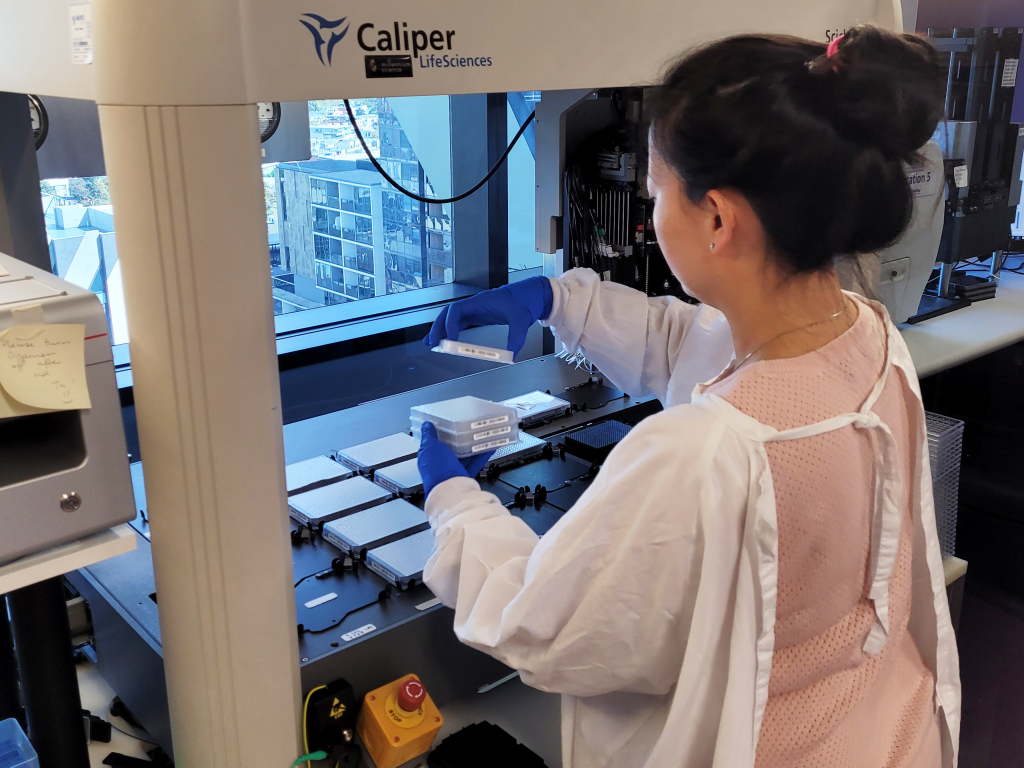
This project was a direct extension of an NHMRC funded 25,000 compound screen performed by the Clemons lab in 2018. Analogues of candidate drugs were prepared in TIA’s core facility Australian Translational Medicinal Chemistry Facility and then tested in cancer cells at Phenomics Australia’s VCFG. Jennii Luu (pictured) added drugs to cancer cells using our robotics.
Defining the role of host microRNAs in COVID-19

‘We thank TIA for the support to undertake an important high-content screen at high biocontainment that sheds light on the replication strategies of SARS-CoV-2 .” Dr Cameron Stewart. Australian Centre for Disease Preparedness (ACDP), CSIRO
Awarded under the TIA-COVID special call for projects. Working with the CSIRO high biosecurity team, this project explored how microRNAs affect SARS-CoV-2 infection. Dr Henry Beetham (pictured) transfected host cells with a microRNA library of 1238 targets housed within the VCFG using our liquid handing robotics. These cells were then returned to CSIRO in Geelong and infected with SARS-CoV-2 under Biosafety level 4 conditions. Cells were fixed, stained and imaged using VCFG’s Cellomics high content microscope to quantify level of expression of SARS-CoV-2.
Defining the role of clonal interaction in high grade serous ovarian cancer drug resistance
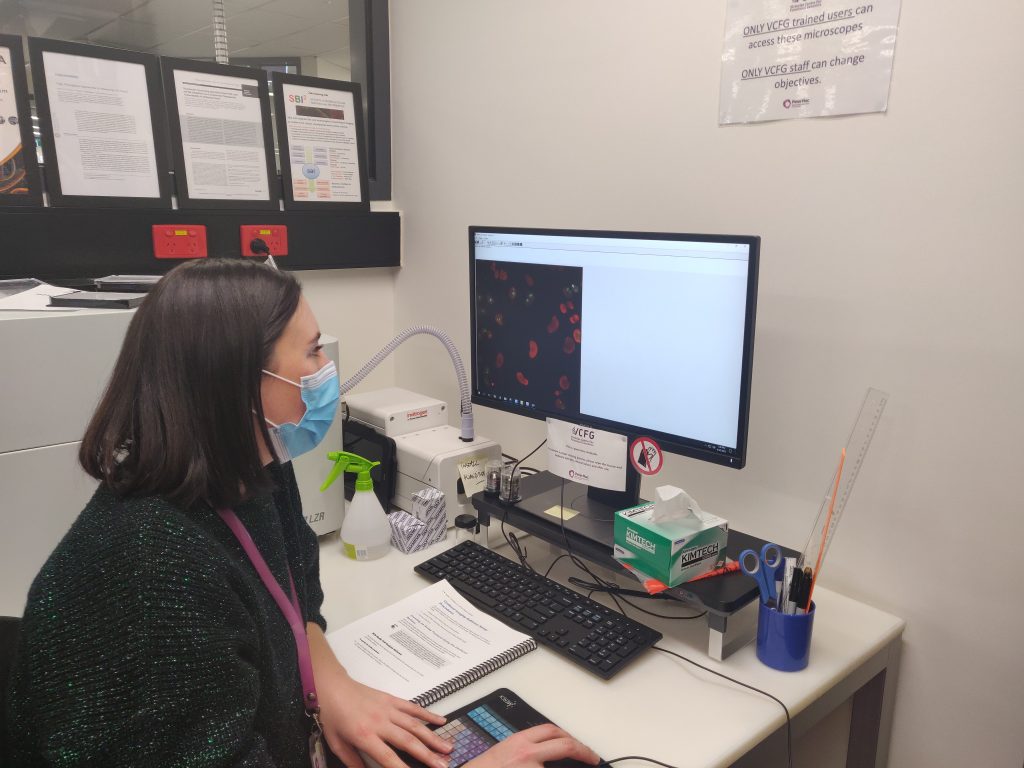
This project used 5 different patient-derived high-grade serous ovarian cancer cell lines that represent different levels of genetic resistance and sensitivity to therapy. Dr Pishas in the laboratory of Dr Liz Christie screened an FDA-approved compound library (Compounds Australia) at multiple doses to identify selective agents that have potential therapeutic advantages. Using high content imaging on stained cells, Karla Cowley (pictured) created custom analysis pipelines to identify how these drugs changed the morphology of the cancer cells when treated with compounds. This work is now published.
‘Generous funding from the TIA allowed us to complete the last puzzle piece of our study to understand how to overcome mechanisms of acquired drug resistance in High Grade Serous Ovarian Carcinoma. With the tremendous assistance and technical expertise of the VCFG, I was able to significantly expand my skill set in the field of high-throughput drug screening as well as generate well-validated data, which has been used for several grant applications. Together with the rich translational track record of the Peter MacCallum Cancer Centre, our TIA findings will improve precision medicine, and the development of novel therapeutic treatment strategies for ovarian cancer patients.” Dr Kathleen Pishas. Peter MacCallum Cancer Institute.
VCFG’s Pipeline Accelerator awards:
Pipeline Accelerator is a voucher scheme developed by TIA to provide researchers and SMEs subsidised access to TIA’s core facilities and high-throughput screening centres. This scheme aims to accelerate the therapeutics development by further reducing the cost of access to expertise and services at TIA facilities.
Dr Michael Sharp
St. Vincent’s Institute of Medical Research
Inhibiting the Fanconi Anaemia pathway to target BRCA1/2 negative breast and ovarian cancers
Dr Kathleen Pishas
Peter MacCallum Cancer Institute
Defining the role of clonal interaction in high grade serous ovarian cancer drug resistance
Dr Sarah Londrigan
University of Melbourne
A universal solution to combat virus-induced respiratory disease
Dr Nicholas Clemons
Peter MacCallum Cancer Institute
A specific inhibitor of SLC7A11 (XCT) for single agent or combination treatment of cancers with mutant p53
Dr Dane Cheasley
Peter MacCallum Cancer Institute
High throughput investigation of synergistic drug combinations for patients with low-grade serous ovarian carcinoma
Dr Cameron Stewart
Australian Centre for Disease Preparedness (ACDP), CSIRO
Defining the role of host microRNAs in COVID-19”
Dr Eleanor Saunders
University of Melbourne
Targeting human leishmaniasis
Dr Shom Goel
Peter MacCallum Cancer Centre
Improving outcomes for breast cancer patients receiving CDK4/6 inhibitors
Prof Frederic Hollande
University of Melbourne
Developing a combined small molecule and immune cell killing assay to identify new therapeutics in pancreatic cancer
Dr Mitchell Lawrence
Monash University
New generation combination therapies for advanced prostate cancer
A/Prof Kara Britt
Peter MacCallum Cancer Centre
Identify drugs that selectively inhibit oestrogen receptor positive luminal progenitor activity
Prof Timothy Stinear
University of Melbourne
A high-throughput screening campaign to find inhibitors of intracellular multi-drug resistant Staphylococcus aureus
Contact us to know more about how we can help with your Functional Genomics and High-throughput Screening.
Additional information
Through the Victorian Centre for Functional Genomics (VCFG) at the Peter MacCallum Cancer Centre, the Harry Perkins Institute of Medical Research (Perkins), and most recently through the ANU Centre for Therapeutic Discovery (ACTD, The John Curtin School of Medical Research, ANU) Monash University, and at the University of Adelaide (in partnership with SAHMRI), Phenomics Australia Functional Genomics and High-throughput screening services enable biomedical researchers Australia-wide with the ability to perform novel discovery-based screens using multiple platforms.
The VCFG provides a collaborative and innovative partnership. Primarily operates a ‘researcher driven, staff assisted’ model working with researchers each step of the way, through assay development, optimisation, transfection and analysis. This partnership begins with a discussion with A/Prof Kaylene Simpson followed by embedding into the laboratory, training on instruments and performing experiments alongside us until project completion. Comprehensive user guides and associated instrument guides are provided. All data generated remains the intellectual property of the researcher. Importantly, each project is customised to the specific biological question, helping drive the project to the best screen outcome possible.
The VCFG is headed by A/Prof Kaylene Simpson and a team of highly experienced research team. A/Prof Kaylene Simpson can be contacted on kaylene.simpson@petermac.org.
